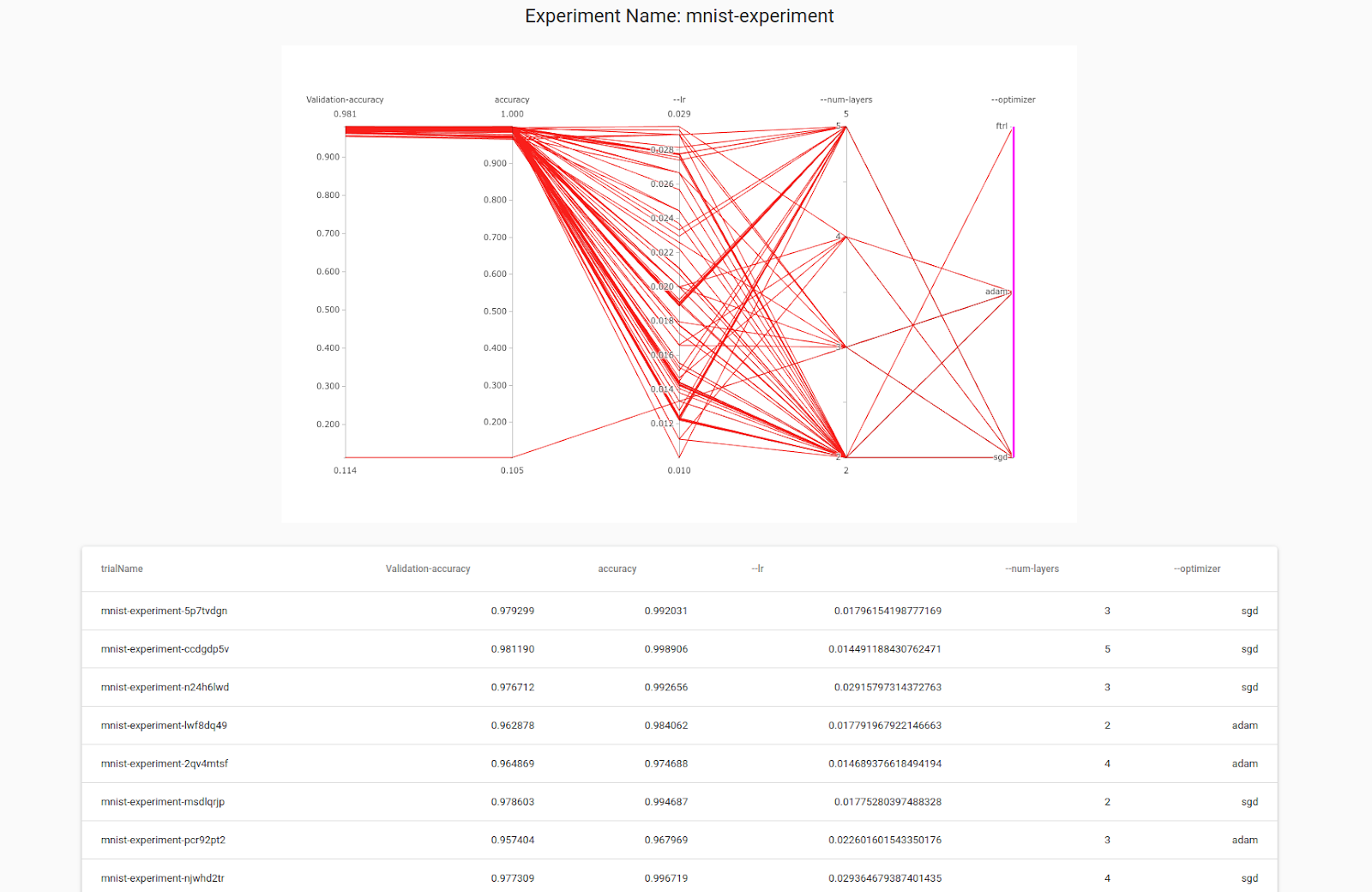Katib is a Kubernetes-based system for Hyperparameter Tuning and Neural Architecture Search. Katib supports a number of ML frameworks, including TensorFlow, Apache MXNet, PyTorch, XGBoost, and others.
- Getting Started
- Name
- Concepts in Katib
- Components in Katib
- Web UI
- API documentation
- Installation
- Quick Start
- Who are using Katib?
- CONTRIBUTING
Created by gh-md-toc
See the getting-started guide on the Kubeflow website.
Katib stands for secretary in Arabic.
For a detailed description of the concepts in Katib, hyperparameter tuning, and neural architecture search, see the Kubeflow documentation.
Katib has the concepts of Experiment, Trial, Job and Suggestion.
Experiment represents a single optimization run over a feasible space.
Each Experiment contains a configuration
- Objective: What we are trying to optimize
- Search Space: Constraints for configurations describing the feasible space.
- Search Algorithm: How to find the optimal configurations
Experiment is defined as a CRD. See the detailed guide to configuring and running a Katib
experiment
in the Kubeflow docs.
A Suggestion is a proposed solution to the optimization problem which is one set of hyperparameter values or a list of parameter assignments. Then a Trial will be created to evaluate the parameter assignments.
Suggestion is defined as a CRD
A Trial is one iteration of the optimization process, which is one worker job instance with a list of parameter assignments(corresponding to a suggestion).
Trial is defined as a CRD
A Worker Job refers to a process responsible for evaluating a Trial and calculating its objective value.
The worker kind can be Kubernetes Job which is a non distributed execution, Kubeflow TFJob or Kubeflow PyTorchJob which are distributed executions. Thus, Katib supports multiple frameworks with the help of different job kinds.
Currently Katib supports the following exploration algorithms:
Katib consists of several components as shown below. Each component is running on k8s as a deployment.
Each component communicates with others via GRPC and the API is defined at pkg/apis/manager/v1alpha3/api.proto.
- Katib main components:
- katib-db-manager: GRPC API server of Katib which is the DB Interface.
- katib-mysql: Data storage backend of Katib using mysql.
- katib-ui: User interface of Katib.
- katib-controller: Controller for Katib CRDs in Kubernetes.
Katib provides a Web UI.
You can visualize general trend of Hyper parameter space and each training history. You can use
random-example or
other examples to generate a similar UI.

See the Katib API reference docs.
For standard installation of Katib with support for all job operators, install Kubeflow. See the documentation:
If you install Katib with other Kubeflow components, you can't submit Katib jobs in Kubeflow namespace.
Alternatively, if you want to install Katib manually, follow these steps:
git clone git@github.com:kubeflow/manifests.git
Set `MANIFESTS_DIR` to the cloned folder.
For installing tfjob operator, run the following
cd "${MANIFESTS_DIR}/tf-training/tf-job-crds/base"
kustomize build . | kubectl apply -f -
cd "${MANIFESTS_DIR}/tf-training/tf-job-operator/base"
kustomize build . | kubectl apply -n kubeflow -f -
For installing pytorch operator, run the following
cd "${MANIFESTS_DIR}/pytorch-job/pytorch-job-crds/base"
kustomize build . | kubectl apply -f -
cd "${MANIFESTS_DIR}/pytorch-job/pytorch-operator/base/"
kustomize build . | kubectl apply -n kubeflow -f -
Finally, you can install Katib
cd "${MANIFESTS_DIR}/katib/katib-crds/base"
kustomize build . | kubectl apply -f -
cd "${MANIFESTS_DIR}/katib/katib-controller/base"
kustomize build . | kubectl apply -f -
If you want to use Katib in a cluster that doesn't have a StorageClass for dynamic volume provisioning at your cluster, you have to create persistent volume manually to bound your persistent volume claim.
This is sample yaml file for creating a persistent volume
apiVersion: v1
kind: PersistentVolume
metadata:
name: katib-mysql
labels:
type: local
app: katib
spec:
storageClassName: katib
capacity:
storage: 10Gi
accessModes:
- ReadWriteOnce
hostPath:
path: /tmp/katibCreate this pv after deploying Katib package
After deploy everything, you can run examples to verify the installation.
This is example for tfjob operator
kubectl create -f https://raw.githubusercontent.com/kubeflow/katib/master/examples/v1alpha3/tfjob-example.yaml
This is example for pytorch operator
kubectl create -f https://raw.githubusercontent.com/kubeflow/katib/master/examples/v1alpha3/pytorchjob-example.yaml
You can check status of experiment
$ kubectl describe experiment tfjob-example -n kubeflow
Name: tfjob-example
Namespace: kubeflow
Labels: <none>
Annotations: <none>
API Version: kubeflow.org/v1alpha3
Kind: Experiment
Metadata:
Creation Timestamp: 2019-10-06T12:25:44Z
Generation: 1
Resource Version: 2110410
Self Link: /apis/kubeflow.org/v1alpha3/namespaces/kubeflow/experiments/tfjob-example
UID: 6b2bef2d-e834-11e9-93ee-42010aa00075
Spec:
Algorithm:
Algorithm Name: random
Max Failed Trial Count: 3
Max Trial Count: 12
Metrics Collector Spec:
Collector:
Kind: TensorFlowEvent
Source:
File System Path:
Kind: Directory
Path: /train
Objective:
Goal: 0.99
Objective Metric Name: accuracy_1
Type: maximize
Parallel Trial Count: 3
Parameters:
Feasible Space:
Max: 0.05
Min: 0.01
Name: --learning_rate
Parameter Type: double
Feasible Space:
Max: 200
Min: 100
Name: --batch_size
Parameter Type: int
Trial Template:
Go Template:
Raw Template: apiVersion: "kubeflow.org/v1"
kind: TFJob
metadata:
name: {{.Trial}}
namespace: {{.NameSpace}}
spec:
tfReplicaSpecs:
Worker:
replicas: 1
restartPolicy: OnFailure
template:
spec:
containers:
- name: tensorflow
image: gcr.io/kubeflow-ci/tf-mnist-with-summaries:1.0
imagePullPolicy: Always
command:
- "python"
- "/var/tf_mnist/mnist_with_summaries.py"
- "--log_dir=/train/metrics"
{{- with .HyperParameters}}
{{- range .}}
- "{{.Name}}={{.Value}}"
{{- end}}
{{- end}}
Status:
Completion Time: 2019-10-06T12:28:50Z
Conditions:
Last Transition Time: 2019-10-06T12:25:44Z
Last Update Time: 2019-10-06T12:25:44Z
Message: Experiment is created
Reason: ExperimentCreated
Status: True
Type: Created
Last Transition Time: 2019-10-06T12:28:50Z
Last Update Time: 2019-10-06T12:28:50Z
Message: Experiment is running
Reason: ExperimentRunning
Status: False
Type: Running
Last Transition Time: 2019-10-06T12:28:50Z
Last Update Time: 2019-10-06T12:28:50Z
Message: Experiment has succeeded because Objective goal has reached
Reason: ExperimentSucceeded
Status: True
Type: Succeeded
Current Optimal Trial:
Observation:
Metrics:
Name: accuracy_1
Value: 1
Parameter Assignments:
Name: --learning_rate
Value: 0.018532845700535087
Name: --batch_size
Value: 109
Start Time: 2019-10-06T12:25:44Z
Trials: 4
Trials Running: 2
Trials Succeeded: 2
Events: <none>When the spec.Status.Condition becomes Succeeded, the experiment is finished.
You can monitor your results in Katib UI.
Access Katib UI via Kubeflow dashboard if you have used standard installation or port-forward the katib-ui service if you have installed manually.
kubectl -n kubeflow port-forward svc/katib-ui 8080:80
You can access the Katib UI using this URL: http://localhost:8080/katib/.
Delete installed components using kubectl delete -f on the respective folders.
Please see Quick Start Guide
Please see adopters.md
Please feel free to test the system! developer-guide.md is a good starting point for developers.
